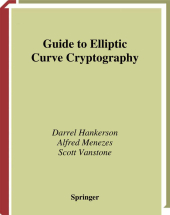 Neuerscheinungen 2010Stand: 2020-01-07 |
Schnellsuche
ISBN/Stichwort/Autor
|
Herderstra▀e 10
10625 Berlin
Tel.: 030 315 714 16
Fax 030 315 714 14
info@buchspektrum.de |

Darrel Hankerson, Alfred J. Menezes, Scott A. Vanstone
(Beteiligte)
Guide to Elliptic Curve Cryptography
Softcover reprint of the original 1st ed. 2004. 2010. xx, 312 S. 34 Tabellen. 254 mm
Verlag/Jahr: SPRINGER, BERLIN; SPRINGER NEW YORK 2010
ISBN: 1-441-92929-0 (1441929290)
Neue ISBN: 978-1-441-92929-7 (9781441929297)
Preis und Lieferzeit: Bitte klicken
After two decades of research and development, elliptic curve cryptography now has widespread exposure and acceptance. Industry, banking, and government standards are in place to facilitate extensive deployment of this efficient public-key mechanism.
Anchored by a comprehensive treatment of the practical aspects of elliptic curve cryptography (ECC), this guide explains the basic mathematics, describes state-of-the-art implementation methods, and presents standardized protocols for public-key encryption, digital signatures, and key establishment. In addition, the book addresses some issues that arise in software and hardware implementation, as well as side-channel attacks and countermeasures. Readers receive the theoretical fundamentals as an underpinning for a wealth of practical and accessible knowledge about efficient application.
Features & Benefits:
Breadth of coverage and unified, integrated approach to elliptic curve cryptosystems
Describes important industry and government protocols, such as the FIPS 186-2 standard from the U.S. National Institute for Standards and Technology
Provides full exposition on techniques for efficiently implementing finite-field and elliptic curve arithmetic
Distills complex mathematics and algorithms for easy understanding
Includes useful literature references, a list of algorithms, and appendices on sample parameters, ECC standards, and software tools
This comprehensive, highly focused reference is a useful and indispensable resource for practitioners, professionals, or researchers in computer science, computer engineering, network design, and network data security.
Contents
List of Algorithms
List of Tables
List of Figures
Acronyms
Preface 1 Introduction and Overview
1.1 Cryptography basics
1.2 Public-key cryptography
1.2.1 RSAsystems
1.2.2 Discrete logarithmsystems
1.2.3 Elliptic curve systems
1.3 Why elliptic curve cryptography?
1.4 Roadmap
1.5 Notes and further references 2 Finite Field Arithmetic
2.1 Introduction to finite fields
2.2 Primefieldarithmetic
2.2.1 Addition and subtraction
2.2.2 Integer multiplication
2.2.3 Integer squaring
2.2.4 Reduction
2.2.5 Inversion
2.2.6 NISTprimes
2.3 Binary field arithmetic
2.3.1 Addition
2.3.2 Multiplication
2.3.3 Polynomial multiplication
2.3.4 Polynomial squaring
2.3.5 Reduction
2.3.6 Inversion and division
2.4 Optimal extension field arithmetic
2.4.1 Addition and subtraction
2.4.2 Multiplication and reduction
2.4.3 Inversion
2.5 Notes andfurther references 3 Elliptic Curve Arithmetic
3.1 Introduction to elliptic curves
3.1.1 Simplified Weierstrass equations
3.1.2 Group law
3.1.3 Group order
3.1.4 Group structure
3.1.5 Isomorphism classes
3.2 Point representation and the group law
3.2.1 Projective coordinates
3.2.2 The elliptic curve y2 = x3 +ax +b
3.2.3 The elliptic curve y2 +xy = x3 +ax2 +b
3.3 Point multiplication
3.3.1 Unknown point
3.3.2 Fixed point
3.3.3 Multiple point multiplication
3.4 Koblitz curves
3.4.1 The Frobenius map and the ring Z[˘]
3.4.2 Point multiplication
3.5 Curves with efficiently computable endomorphisms
3.6 Point multiplication using halving
3.6.1 Point halving
3.6.2 Performing point halving efficiently
3.6.3 Point multiplication
3.7 Point multiplication costs
3.8 Notes andfurther references 4 Cryptographic Protocols
4.1 The elliptic curve discrete logarithm problem
4.1.1 Pohlig-Hellmanattack
4.1.2 Pollard┤s rho attack
4.1.3 Index-calculus attacks
4.1.4 Isomorphism attacks
4.1.5 Related problems
4.2 Domain parameters
4.2.1 Domain parameter generation and validation
4.2.2 Generating elliptic curves verifiably at random
4.2.3 Determining the number of points on an elliptic curve
4.3 Keypairs
4.4 Signature schemes
4.4.1 ECDSA
4.4.2 EC-KCDSA
4.5 Public-key encryption
4.5.1 ECIES
4.5.2 PSEC
4.6 Keyestablishment
4.6.1 Station-to-station
4.6.2 ECMQV
4.7 Notes and further references 5 Implementation Issues
5.1 Software implementation
5.1.1 Integer arithmetic
5.1.2 Floating-point arithmetic
5.1.3 SIMD and field arithmetic
5.1.4 Platform miscellany
5.1.5 Timings
5.2 Hardware implementation
5.2.1 Design criteria
5.2.2 Field arithmetic processors
5.3 Secure implementation
5.3.1 Power analysis attacks
5.3.2 Electromagnetic analysis attacks
5.3.3 Error message analysis
5.3.4 Fault analysis attacks
5.3.5 Timing attacks
5.4 Notes and further references A Sample Parameters
A.1 Irreducible polynomials
A.2 Elliptic curves
A.2.1 Random elliptic curves over Fp
A.2.2 Random elliptic curves over F2m
A.2.3 Koblitz elliptic curves over F2m
B ECC Standards
C Software Tools
C.1 General-purpose tools
C.2 Libraries
Bibliography
Index


